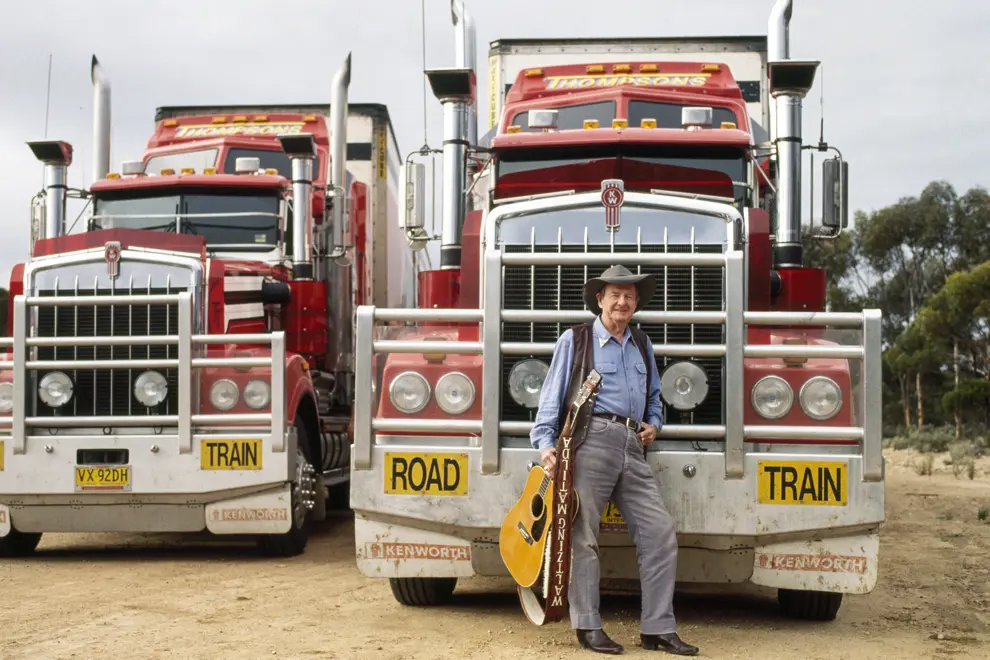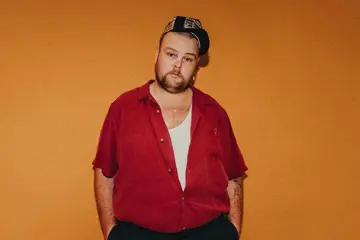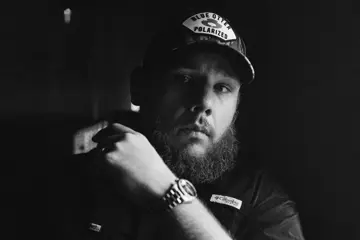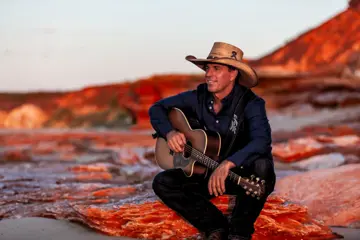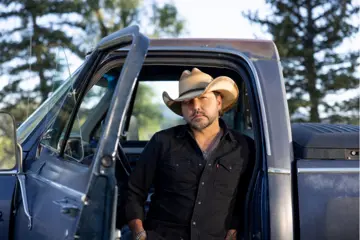When Slim Dusty’s wife, Joy McKean, and daughter, Anne Kirkpatrick, donated Slim’s 1971 Ford Fairlane to the Slim Dusty Centre in Kempsey, they were sad to see “Old Purple” go.
“It was still going like a bird, even though it had gone three times around the clock,” Anne smiles. “And that was just Mum and Dad’s ‘later years’ – they had done plenty of touring before that, in the ’50s and ’60s.”
No Australian artist had more miles on the clock than Australia’s king of country, who died 21 years ago.
Slim’s approach was simple – he took his music to the people.
“The road has a certain attraction and a certain pull,” Joy explained. “It’s a great feeling when you know you can just go.”
Slim and Joy’s never-ending tour started 70 years ago.
“We decided that we could do three months,” Joy recalled. “We started off on the 19th of September 1954, with £19 in our pockets. Anne was two, and we had gambled all we had except the house.”
Joy’s brother Bob set out ahead, visiting towns and putting up posters: “At last, the Slim Dusty Show!”
Joy chuckled at the memory of the promotional campaign. “You’d think the whole nation had been panting for Slim Dusty to appear on the horizon. Talk about naïve hillbillies!”
It became the annual Slim Dusty Australian tour – a 30,000-mile (48,280km) round trip. Now, that’s a tour. As Slim sings on Gone Truckin’, the new compilation released today, he was under the spell of Highway One.
Join our community with our FREE weekly newsletter
Slim recorded more than 80 trucking songs during his career, and Gone Truckin’ gathers 24 of the classics, including I’m Married To My Bulldog Mack, Bent-Axle Bob, No Good Truckin’ Man and Dieseline Dreams.
Truckies love Slim Dusty. In him, they see a kindred spirit, someone who travelled the same roads.
“The truckies are a real community, and they look after their own,” Anne points out. “To be invited into that community is very special, and it meant a lot to Dad and to Mum that they were invited in.”
Slim Dusty didn’t write Gotta Keep Movin’ – it was written by John Flanagan and Mike Perjanik – but it could have been his theme song:
“Now, I’m the sort of man who could never stay still,” he sang. “Hey, the road is open an’ I’m rollin’ free, you see/ I feel so good as long as I’m movin’.”
Beneath the song on YouTube, you’ll find this comment:
“I’m a Swedish truckie, mate. But I listen to Slim Dusty, he’s singing about what I feel.”
And another YouTube comment sums up Slim’s universal appeal: “It’s amazing what music will do. I listen to ol’ Slim Dusty almost every day at work and it makes me feel like I miss beautiful Australia – even though I have not visited yet.”
Gone Truckin’ was curated by Anne and her brother, David Kirkpatrick, in association with EMI, which has been Slim’s recording home since 1946.
“EMI/Universal are like family,” Anne says. “They are so committed to preserving the legacy of my mum and dad.”
Slim was the first artist in the world to record 100 albums with the same label. And he has sold more albums in Australia than any other local act – more than seven million.
Slim was working on his 106th album when he died at home in St Ives in 2003 after a battle with lung and kidney cancer. He was 76.
Gone Truckin’ reveals much about the Aussie legend – including the fact he was a “Trekkie”.
The album features a song called Star Trucker, which Graeme Connors wrote for Slim. It’s one of the first cosmic cowboy hits, a strange mix of sci-fi and life on the road.
“Dad was a Trekkie,” Anne reveals. “He was a huge fan of the Star Trek TV series.”
The Dusty roads tell quite the story. Rock historian Glenn A. Baker says Slim and Joy blazed a trail for other artists.
“They [Slim and Joy] would go to places that nobody else had gone to. They really did beat a path – and not once, but regularly. They would go back every year. I have spoken to members of Indigenous bands – Coloured Stone and the Warumpi Band and No Fixed Address – they came of age listening to Slim. They thought Slim was an absolute hero because he kept coming back.”
Australia’s first Indigenous chart-topper, Jimmy Little, admired Slim. “He would take his shows to the community, to the public, who appreciated him to no end. Because he did that constantly, he became a national hero in the eyes of the Indigenous Australians and non-Indigenous Australians.”
“Slim crossed all racial divides with music, he pulled a lot of people together,” Troy Cassar-Daley believes.
“All these people out in the bush, you’d almost think they were waiting for Slim, someone like Slim to come along,” Joy said. “He did become a voice for them.”
Slim inspired many young musicians, including our biggest country export. In the 1996 book Another Day, Another Town, Slim wrote about taking “a way-out young artist, Keith Urban, on tour with me”.
Urban particularly loves Lights On The Hill, Slim’s first trucking anthem, which is now the opening track on Gone Truckin’. When he was 11, Urban got Slim to sign his sheet music, and they later recorded the song together. Urban called the song “bulletproof”. And Paul Kelly hailed the track as “really beautiful and interesting – the music and the lyrics are at odds and I love that kind of writing”.
Lights On The Hill was released as a single in 1972, and it became the title track of Slim’s first trucking album in 1975. It was written by Joy, who was responsible for many of Slim’s hits. “We knew each other just so well. I could express many things for Slim that even he could not express for himself.”
Joy’s own experiences behind the wheel inspired Lights On The Hill. It was a dark, rainy night in June, and she was driving the car and caravan on her own on a stretch of road between Armidale and Guyra called Devil’s Pinch. Because of her polio-affected left leg, Joy could use only one foot to operate the accelerator, brake and dimmer switch on the floor. It was a scary trip, but when she made it to Warwick about 10 o’clock, she told Slim: “I wrote a song on the way.”
Not that Slim instantly embraced Lights On The Hill. “Firstly, it was not my style,” he complained. “Secondly, it had too many words. And thirdly, I wasn’t going to use it.”
“The other classic story,” Anne reveals, “is that he taped over Mum’s demo cassette when he was putting down some other demo, so Mum had to redo it.”
Slim decided to record Lights On The Hill only when he saw the reaction Joy got when she performed the song live. “Once Dad got his teeth into it, he just made it a hit,” Anne says. “People don’t realise what an incredible singer he was, what a range he had. And Mum loved to challenge him.”
Joy – who died last year, aged 93 – also contributed The Lady Is A Truckie to Slim’s truckie canon. “That’s a true story,” Anne reveals.
It’s about Toots – real name Thora Holzheimer – who was the first Australian woman to clock a million miles in a truck. “She was an amazing pioneer for women in the trucking industry, a legend in the trucking world and in Australian folklore. And she was a real character, doing that run from Cairns right up to Cape York.” Toots’ truck can now be found at Winton’s Diamantina Truck Museum.
Gone Truckin’ also includes some songs that Slim co-wrote, including Truckin’s In My Blood and Road Train Blues. “Oh, I love that song,” Anne says. “Dad wrote Road Train Blues with Stan Coster. It really was the precursor to the whole truck thing. He wrote a lot of songs with Stan, and they’d always catch up on the road.”
When Slim released his 1997 trucking album Makin’ A Mile, he drove a T900 Kenworth road train across the Nullarbor. “That was a great experience for Mum and Dad,” Anne says. “They got a real sense of what it was really like for truckies on those long-haul trips.”
Anne has had her own significant recording career. In his last major interview, Australian record producer Mark Moffatt highlighted how Anne’s 1991 album Out Of The Blue was a watershed moment in Australian country music. “It opened the door for a lot of contemporary country stuff and Americana in Australia,” he said. “Kasey Chambers, and many other artists, walked through the door that Anne opened.”
Anne also got to make two albums with her dad – 1989’s Two Singers One Song and 2002’s aptly titled Travellin’ Still … Always Will. “That was the last full studio album that Dad recorded, and he insisted that the song I wrote, about him and Mum, became the title track. That is very special to me.”
Anne is keen to return to the recording studio, though her focus is on preserving her mum and dad’s remarkable legacy.
Gone Truckin’ is the second in a series of Slim Dusty “thematic” albums, following 2021’s Gone Fishin’. Who knows what’s coming next, but one thing is certain: Gone Drinkin’ is gonna be a classic.
These albums show that Slim Dusty’s music will never die. He approached his career the way a truck driver approached the wide-open road.
Keep on truckin’.
Gone Truckin’ is out now via EMI/Universal Music Australia. You can buy/stream the album here.
